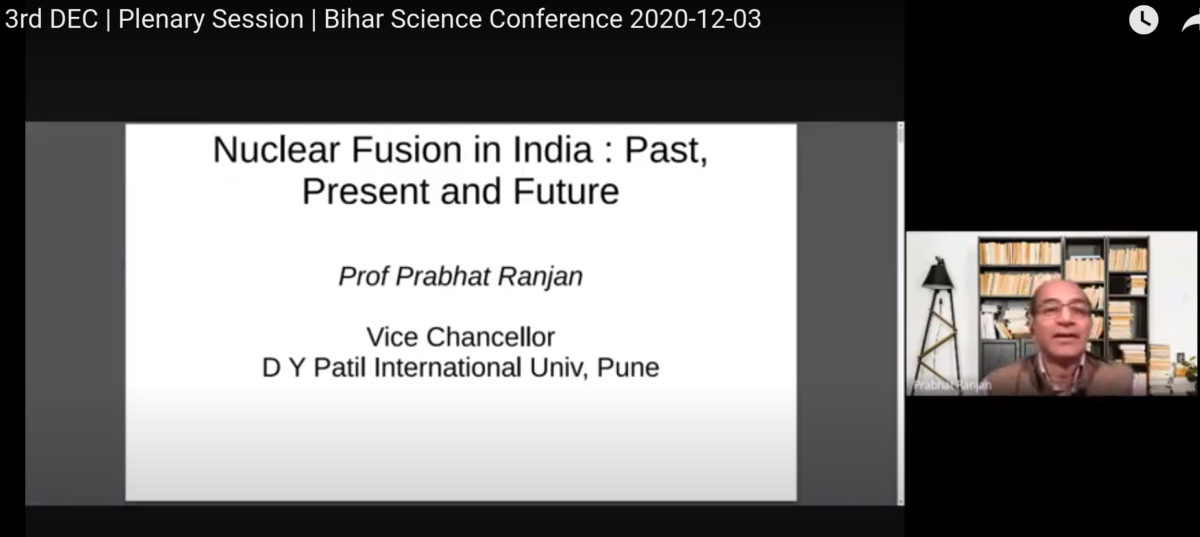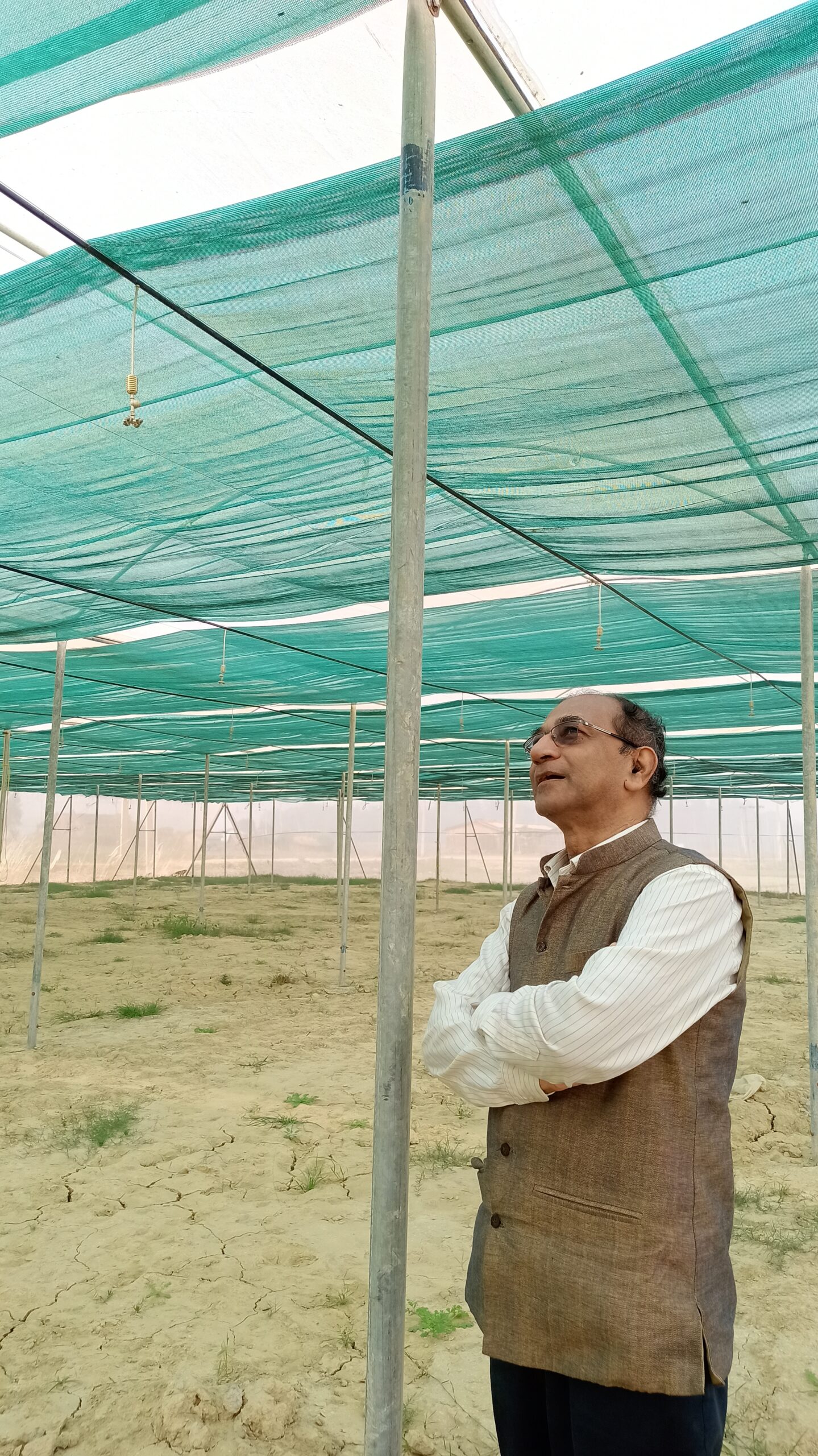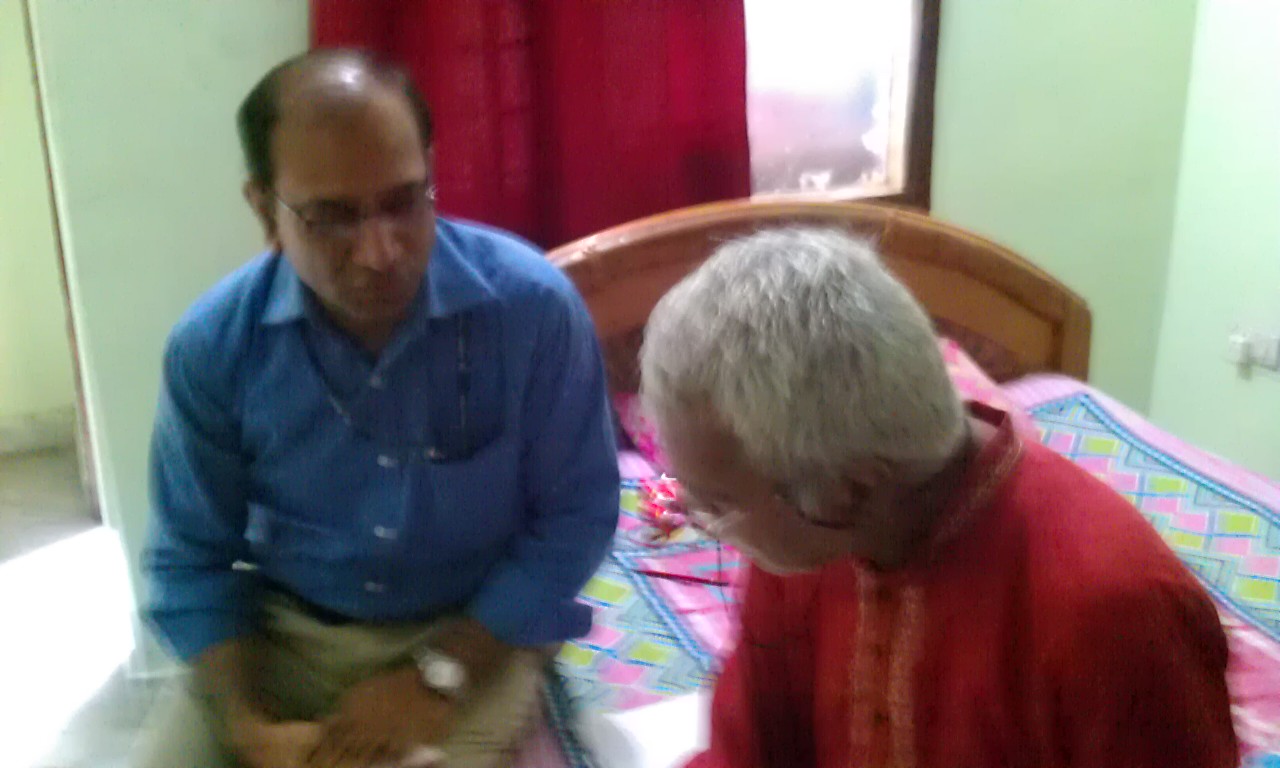This is video of a plenary talk that was given at Bihar Science Conference on Dec 3, 2020 held online. Talk gives overall progress of nuclear fusion in last 4 decades in India and where we need to go. The talk also makes historic announcement regarding a privately funded Nuclear Fusion project in India code named – Project Sanlayan. Here is the link to video – talk starts after 3:00 minutes.
Category: Bihar
Visit to my Village Narayanpur(Darbhanga, Bihar) after 8 years
I wrote this blog mainly to describe the changes I noticed in my villlage after a long gap of 8 years. I believe that these changes happening in the rural area are not being noticed by the policy makers and entrepreneurs. I feel that there are new possibilities .
My first memory of my village goes to an incident in my early childhood when I suffered a burn when a rice pot tumbled and I also happened to fall in the hot water. It is still itched in my memory. I remember learning to walk again by holding walls. I also remember having gone through a near death experience in my mother’s native village when I was drowning in a pond while learning to swim. I used to visit my village once in 4-5 years when some family functions used to take place.
Continue reading “Visit to my Village Narayanpur(Darbhanga, Bihar) after 8 years”My interaction with Dr Vashishtha Narayan Singh (Vashishtha Jee) (Edited : Nov 16, 2019)
[Edited : Due to lot of wrong facts circulating on Internet, I have tried to collect factual information about Vashishtha Jee. I am sharing the data here. If any one has suggestion to correct it or improve it, please let me know.

 ]
]
===============================================================================
I suddenly saw a message on WhatsApp about sad demise of Vashishtha Jee some time ago(Nov 14, 2019) and did not believe it. I tried to contact Dr Birendra Jee, his batchmate and close friend. He also confirmed the sad news. Many thoughts went through my mind and I felt that I must jot them down.
Bihar Gaurav Samman from Shri Narendra Modi – in 2012
Experiences with Patna Marathon
This is a post I had made on April 5, 2012 in Patna Marathon forum on Facebook. Since time to time references are made to Patna Marathon not being held as scheduled, I am reproducing this post here so that others can look at it.
Use of ICT and Sensor Network Technology in Agriculture in Bihar
Bihar Govt has rightly recognized the potential of agriculture in growth of Bihar. For this purpose a separate “Agriculture Cabinet” has been formed. Road map for agriculture for next 10 years with a massive outlay has been planned as well.
In November and December 2011, I made two visits to Bihar and interacted with Agricultural Research Institute, Farmers and some young Social Entrepreneurs focusing on agriculture. I have also noticed the fact that some of the farmers in Bihar have done world record production of paddy and this encourages me to write this brief note.
In 2011, on behalf of IIT Alumni (Gujarat Chapter) I signed an MOU with Gujarat Govt to “Improve Agricultural Yield using Technology”. I feel that some of the points mentioned in that MOU are also relevant to Bihar. I am willing to work together with Bihar Govt to develop these technologies. The technologies that I am talking about are not part of standard agricultural technologies being covered but are more recent and are under development worldwide. While I would have hesitated to discuss such technologies in Bihar earlier since they would only be beneficial after farmers have started utilizing existing technologies. However now that I have noticed Bihar making fast progress in agriculture, I feel that time is ripe to take up research and development, which would take Bihar to next level and keep it ahead in Nation and World. I would mention these as follows:
Precision farming using sensor network– using the localized sensors linked with wireless communication system to provide real time feedback on various parameters which affect crop yield. As compared to the developed countries, our farm sizes are very small hence we need to develop low cost solutions based on latest advancements in MEMS sensors, micro radio transceivers and processing systems. This would allow us to monitor the spatial variation in moisture, soil properties, hardpan, nutritional status etc. on a much smaller scale.
This kind of technology would allow us to improve the quality of our fruits and vegetables as well as products being developed in green houses. While the basic concept is not new, it is critical to develop such technology at very low cost to make it economical to farmers in Bihar.
Use of Space Technology through Hyper Spectral Imaging– Using the advances in Communication and Remote sensing to create a systematic natural resources database and also to research in the advance area of Hyper Spectral remote sensing to compliment the Soil Health Card Program at ground level.
Soil health card system uses ground level periodic monitoring of soil related information(e.g. every 6 months) based on mobile soil labs to farmers in the villages. This measurement can be supplemented by Hyper Spectral Imaging already available in public domain to provide much greater spatial information and complements the information provided by “Soil Health Card”.
Low cost non-invasive sorting systems – It has now become possible to develop low cost sorting non-invasive machine based on advances in CMOS image sensors and LED light source to sort the agricultural yield based on their attributes such as their quality, size and maturity stage. This would allow farmers to get a better price in the market and would also make it easier for them to access the export market.
Traceability systems development – Traceability is a very important factor in today’s fresh produce industry. With more and more export market coming up with rules for food traceability, it is important to develop low cost technology to meet the needs of food traceability from “seed to plate”.
Traditional systems are very expensive and we need to develop low cost system so that farmers in Bihar are able to export their product in International market, which is going to be crucial for Bihar in next few years.
GIS based planning : Today it has become possible to collect information through remote sensing as well as ground survey using Mobile phones (e.g. Android based systems) regarding crop, water resources, soil condition, weather and all other parameters and add them to a Geographical Information System (GIS) to allow easy access to information and use them in planning. Some of this data can be made available on real time basis through wireless sensor network such as Agro-Weather Sensor Network. It would give a big boost to the way we manage and plan our agriculture.
Innovation Belts for Growth of Bihar – Final Version
Objective
To set up clusters of educational/research and industrial organizations at few geographically distributed locations to promote innovation as well as cater to gap in demand and supply in education within state.
Budget Allocation
I am suggesting investing Rs 1000 Crore per year under this head for next 6 years to develop this in the state at rapid rate. Rough idea about how this figure is arrived at is given in a later section.
Advantage to State
- Reduce the gap in quality education seat demand and supply, which is very large in Bihar as of now and among the worst in India
- Multiple institutions would support ecosystem to promote innovations cutting across disciplines Would make it easier to develop infrastructure at few of these locations and support better quality of life, needed to attract quality faculty
- Today most couples are working and they need opportunity in close proximity – due to this they tend to prefer metro cities. Proposed clusters like this would increase such possibilities
- Link education to Innovation in various aspects of importance to Bihar : e.g Agriculture, Healthcare, Tourism and also generate industry based on innovation – Make Bihar innovation hub of country
- Generate skilled manpower at all levels and attract industry. In turn, industry would also help these institutions.
- Would lead to direct and indirect job creation within state and stem the migration
- New township and related infrastructure would develop providing economic growth to state
Background
Bihar has been land of innovation in the past and till today this signifies the glory of Bihar. Innovations were in many fields and included new thought processes through “religion” (e.g. Buddhism or Jainism), Mathematics, Astronomy, Politics, Economics etc . So Innovation was not limited to scientific or technological innovation.
In today’s context innovation is equally important if Bihar has to grow and maintain its growth and be visible not only on map of India but also of world. So this brief document looks at how to kick start growth of Bihar based on innovations.
Education in Bihar
Education has been the lifeline of Bihar so I feel that any such effort has to start around education. In spite of this, Bihar has severe shortage of educational opportunity. As per statistics in table below, Bihar having nearly 8.6% of population in country has less than 0.4% of Engineering seats(Which may have worsened since I do not have latest data). Compared to states like Tamil Nadu and Andhra, Bihar seems clearly at severe disadvantage. While some efforts have been made in last few years to improve situation, it is clearly no where close to the kind of effort needed. We still have a huge gap in demand and supply. Bihar students go all over the country and flood colleges around the country. According to one data, nearly 1 Lakh students go out of Bihar every year for engineering education alone with an outflow of Rs 2000 Crores. Even a far off place like Kota having coaching facilities, 60% of students out of 50,000 are from Bihar. This figure would go up substantially (may be several times), if we add all education groups including schools.
So do we go ahead and build educational institutes in all districts or we plan it according to certain state level plan? It should be understood that just increasing number of educational seats without caring for quality is not going to help.
So a very critical issue is about increasing number of quality seats (in various educational segments). A second aspect is to make sure that the system promotes innovation through education so that state can become hub of innovation. This would lead to improving not only various aspects of state through innovation but also make sure that industry would develop by promoting entrepreneurship around these innovations.
With very scares resources, it would not be foolish to let these institutes be made at random and scattered geographically. What this paper suggests is to organize such institutes in clusters, which I am referring to as “Innovation Belt” at about 6 locations in Bihar.
Innovation Belt
These “Innovation Belts” are clusters of educational organizations of various kinds ( I have given examples of Engineering colleges but these clusters would cover all kind of educational organizations including schools, ITIs, Diploma institutes etc) along with research institutes and facility for setting up industry along with relevant industry itself.
These “belts” can be setup in a 5-6 geographical regions spread over Bihar. For example, these could be : (1) Motihari (2) Darbhanga (3) Kishanganj (4) Bhagalpur (5) Gaya and (6) Siwan. This is shown in the map to show the spread (green dots indicate new areas to be developed where as red dots indicate already existing organizations need to be brought under this concept).
How I have arrived at these locations?
Most of these belts would need some kind of “nucleus” organization to kick start the process of development around it. Some of these could be a new upcoming organization or some due to certain historical significance. I have also kept in mind geographical distribution of such belts to spread them across state. Let me give some reasons:
Gaya: This belt would extend from Gaya to Nalanda of about 70 kms. It is most suited for early development due to easier availability of land, airport at Gaya, good rail link, Magadh University (with very large campus), International tourist circuit, Nalanda International University(upcoming) etc.
Motihari : this belt extends from Motihari to Bettiah of about 50 kms. Due to significance of this place in Independence movement, Chief Minister announced development of Central University or something similar at this place. So this can become the nucleus around which rest of the cluster can develop. In addition Medical colleges are being setup as well. This area is rich in sugarcane, forest resource, wildlife etc. Proximity to Nepal bring another dimension too. Innovation belt in this region can take advantage of these to have its unique character.
Darbhanga: This belt extends from Darbhanga to Madhubani of about 35 kms. It already has well known medical college (DMCH) and Mithila University along with other institutes.
Kishanganj: Bihar govt has already provided land to set up Aligarh Muslim University here. This can be nucleus around which innovation belt can be setup. This can extend towards Purnea side. This area is quite underdeveloped but has good connectivity by rail and road. Airport at Bagdogra has regular flights and is about 90 kms from here.
Bhagalpur: This belt could extend from Bhagalpur to Bikramshila about 40 kms away. Bikramshila being ancient seat of learning would provide appropriate historical background for “Innovation Belt”. Some of the very big power projects are coming up here.
Siwan: Siwan is the birth place of Dr Rajendra Prasad and it is befitting that Siwan should be one of the innovation belts. This can cover the region between Siwan and Gopalganj of about 35 kms. This area has high inflow of remittance from abroad. According to some estimate Rs 2600 Crore inflow per year is there, which does not find proper investment possibilities. So this region is ripe for private investment in such a venture. This area has lot of possibilities in the area of Agriculture and related industry.
Cost of development of such belts
If we try to achieve 50% of all India average in engineering seats through these belts, we would need to add additional 40000 seats. Rough cost of development of these would be about Rs 3,000 Crores. If we add additional capacity for all other types of institutes, we can roughly estimate this to be Rs 20,000 Crores. Out of this, if state govt spends about 30%, we can target 70% of funds to come from other sources (Central govt, Private funds and International sources). So state govt needs to spend about Rs 6000 Crores and Rs 14000 Crores would need to come from other sources.
Simultaneous planning should be done to connect these belts to each other through high speed communication link. For example some of the belts may be close to proposed “Eastern Economy Corridoor”. We can provide high speed linkage to this. At other places, we can strengthen the communication link.
How Innovation can be promoted through education ?
Our education system by and large promotes rote learning at both school level and college level. This does not promote culture of innovation. To change this we need to focus in a different way of learning. This can be done through modern methods based on “Project based learning”, Team Work, Development of Self Learning etc.
Examples of such clusters
Such education needs to be imparted at both school level as well as college level. At school level School of Creative Learning, Patna (operating for last 15 years) has already been working along these lines. We need to identify if anything more needs to be added to this system and if one can replicate similar systems to promote creativity and innovation at school level.
At college level, Olin College in USA is a model. It was set up about 10 years back and has focused on promoting innovation. It has worked on “Project based learning” model. Another good example of innovation is through “extreme affordability” course of Stanford Design School through Interdisciplinary research.
Within India, we have many examples of educational clusters. One good example is Vallabh Vidyanagar near to Anand. In about 50 years from scratch, it has now 92 educational institutes catering to nearly 1 Lakh student along with industry. However they have not really focused on innovation as a goal education.
References:
- Bihar Grand Total: Diploma Courses (5,125) + Post Diploma Courses (30) + Part-Time Diploma Courses (180) = 5,335. ( http://www.sbtebihar.gov.in/Intake/IntakeCap13.htm )
- Engineering Degree College : 3779 (http://dst.bih.nic.in/EngineeringColleges.aspx )
- http://www.careers360.com/news/4134-One-million-engineering-seats-in-India
- http://www.indianexpress.com/news/why-engineering-seats-find-few-takers/816041/0
[PS : See this note

By Elizabeth Popp Berman
]






